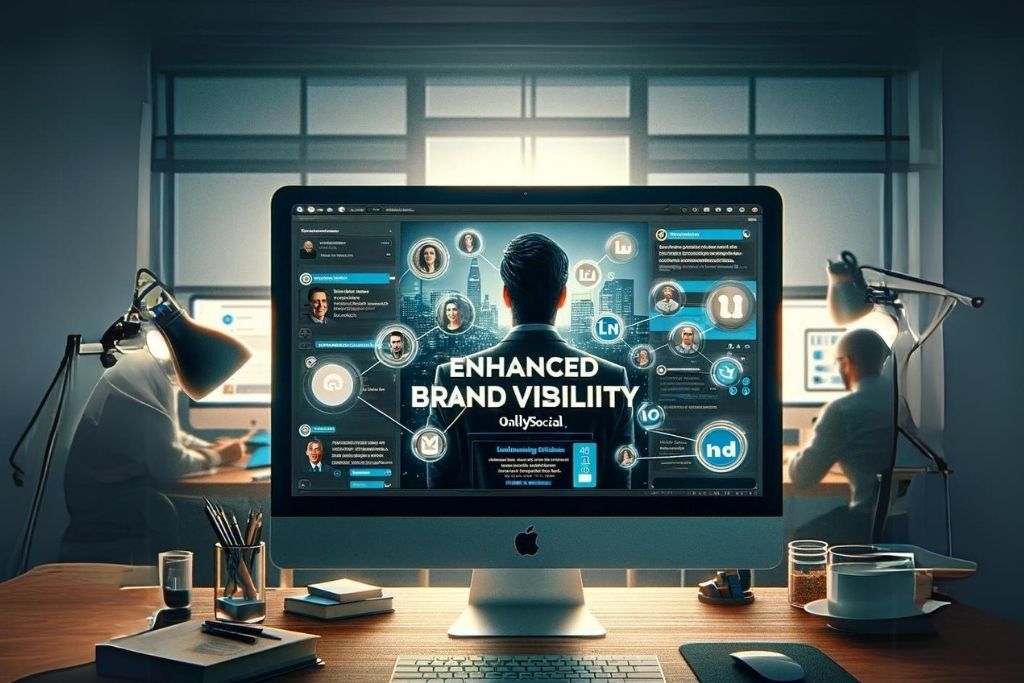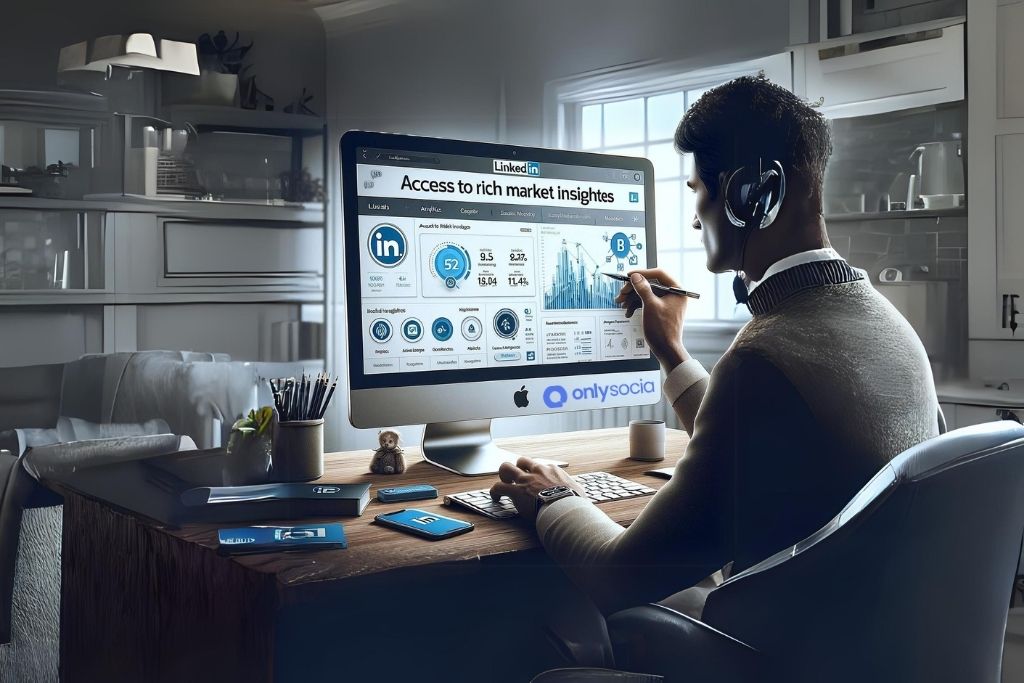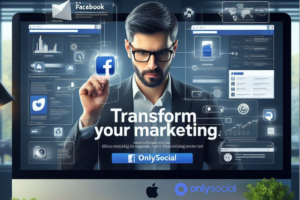In today’s digital-first world, the significance of professional networking sites in shaping the trajectory of business success has never been more pronounced. Among these platforms, LinkedIn emerges as a frontrunner, offering unparalleled opportunities for businesses aiming to expand their reach, enhance their brand, and connect with their target audience. Leveraging LinkedIn for business in 2024 is not just a strategic move; it’s a necessary one for companies looking to navigate the complexities of the digital marketplace effectively.
This guide delves into the myriad ways businesses can harness the power of LinkedIn, from building a robust brand presence and forging meaningful professional connections to tapping into insightful analytics and driving targeted marketing campaigns. With over 700 million professionals worldwide, LinkedIn provides a rich tapestry of potential customers, partners, and talent, making it an indispensable tool for business growth and development. As we explore the key benefits of leveraging LinkedIn for business, it becomes clear that mastering this platform can open doors to new opportunities, foster valuable relationships, and significantly impact your business’s bottom line.
Table of Contents
Enhanced Brand Visibility

Building a Professional Brand Presence
Leveraging LinkedIn for business growth begins with establishing a strong brand presence on the platform. This involves crafting a compelling company page that highlights your mission, values, and what sets you apart from competitors. Regularly updating your page with news, achievements, and insightful content can keep your audience engaged and informed. Additionally, sharing articles and posts that showcase your industry expertise not only positions your brand as a thought leader but also increases your visibility to potential clients and partners.
Utilizing LinkedIn Articles and Posts
Creating and sharing valuable content is key to leveraging LinkedIn for business. By publishing articles directly on LinkedIn, you can tap into the platform’s vast network of professionals and engage with your target audience. Focus on topics that are relevant to your industry and provide unique insights or solutions to common challenges. This strategy not only boosts your brand’s visibility but also encourages shares and discussions, further expanding your reach.
Leveraging Employee Networks
Your employees are your brand’s most powerful advocates. Encouraging them to engage with and share your company’s content can significantly amplify your visibility on LinkedIn. When employees share updates, articles, and achievements, they not only showcase your company culture but also extend your content’s reach to their networks. This can lead to increased brand recognition and opportunities for business growth. Implementing a structured employee advocacy program can streamline this process and maximize the benefits of leveraging LinkedIn for business.
The Multiplier Effect on Visibility Through Employee Advocacy
Employee advocacy on LinkedIn can create a multiplier effect, dramatically increasing your brand’s visibility. As employees share content, their networks—comprising potential clients, industry peers, and future employees—receive insights into your brand’s values, achievements, and expertise. This not only broadens your reach but also enhances your brand’s credibility and appeal, fostering trust and interest among a wider audience.
Targeted Networking Opportunities

Leveraging LinkedIn for business growth extends significantly into the realm of targeted networking opportunities. This powerful platform offers a unique space for connecting with industry leaders, engaging with peers, and exploring potential business partnerships. Here’s how businesses can make the most of these opportunities in 2024.
Connecting with Industry Leaders
- Strategies for Engaging with Thought Leaders: To truly leverage LinkedIn for business, it’s crucial to identify and connect with industry leaders and influencers. This involves following their content, engaging in meaningful conversations, and sharing their insights with your network. By positioning your business as an active participant in industry dialogues, you can elevate your brand’s profile and establish credibility.
- The Role of LinkedIn Groups in Professional Relationships: LinkedIn Groups are a goldmine for targeted networking. By joining and actively participating in groups relevant to your industry, you can interact with like-minded professionals and thought leaders. These interactions can lead to collaborations, mentorship opportunities, and even new business ventures.
B2B Networking and Partnerships
- Utilizing LinkedIn for B2B Lead Generation: LinkedIn’s targeted search features allow businesses to identify potential B2B clients and partners with precision. By leveraging LinkedIn for business connections, companies can directly reach out to decision-makers, present their offerings, and initiate discussions that could lead to profitable partnerships.
- Best Practices for Initiating and Nurturing Professional Partnerships: Establishing a connection is just the beginning. Nurturing these relationships through regular engagement, providing value through insightful content, and being responsive to inquiries can solidify these connections. Sharing updates about your business, celebrating milestones, and endorsing the skills of your connections foster a reciprocal relationship that can lead to long-term collaborations.
Access to Rich Market Insights

Leveraging LinkedIn for business growth offers unparalleled access to rich market insights that are critical for informed decision-making and strategic planning. Here’s how you can tap into these insights to stay ahead of the curve.
Industry Trends and Analysis
Understanding the Pulse of Your Industry
- LinkedIn serves as a real-time barometer for industry trends. Regularly engaging with content shared by industry leaders and participating in relevant discussions can provide early indications of shifting trends, emerging technologies, and new market demands.
Leveraging LinkedIn Articles and Thought Leadership
- Many professionals and companies publish detailed analyses and predictions about industry movements on LinkedIn. By following these publications, businesses can gain valuable insights into future trends and position themselves accordingly.
Using LinkedIn for Competitive Analysis
- Keep an eye on the content and updates shared by competitors on LinkedIn. This can offer insights into their strategies, upcoming products, or services and reveal gaps in the market that your business can exploit.
Competitor Monitoring
Tools for Tracking Competitor Activity
- LinkedIn offers several tools and features that can help businesses monitor their competitors’ activities. This includes following their company pages, keeping tabs on their posts, and noting engagement levels and audience growth.
Benchmarking Your Performance
- By analyzing competitors’ successes and failures on the platform, businesses can benchmark their performance and adjust their LinkedIn strategies to capture more market share. This could involve enhancing content quality, increasing posting frequency, or refining targeting parameters.
Identifying Partnership and Collaboration Opportunities
- Observing interactions and partnerships between industry players on LinkedIn can uncover opportunities for collaborations, joint ventures, or even acquisitions that could be beneficial for growth.
Tailored Content Strategies Based on Engagement Metrics
Analyzing Engagement to Inform Content Creation
- LinkedIn’s analytics tools allow businesses to understand which types of content resonate most with their audience. This data can guide the development of future content strategies, ensuring they meet the interests and needs of target audiences.
Adapting to Audience Preferences
- Leveraging LinkedIn for business success involves adapting to the changing preferences of your audience. Regular analysis of engagement metrics can reveal shifts in audience behavior, enabling businesses to tailor their content and interactions to maintain relevance and interest.
Effective Talent Recruitment
Leveraging LinkedIn for Business Growth Through Talent Acquisition
Streamlining the Hiring Process
- Introduction to LinkedIn’s Recruitment Tools: Explore how leveraging LinkedIn for business can revolutionize your recruitment process with its advanced tools and features. Dive into LinkedIn Recruiter, LinkedIn Jobs, and the platform’s intelligent matching algorithms that connect employers with the right candidates.
- Crafting Compelling Job Postings: Learn the art of creating job postings on LinkedIn that stand out. This includes tips on using specific keywords, highlighting company culture, and the benefits of incorporating multimedia elements to attract top talent.
Employer Branding
- Building a Strong Employer Brand on LinkedIn: Understand the significance of employer branding in leveraging LinkedIn for business and talent recruitment. Discuss strategies for showcasing your company culture, values, and employee testimonials to create an attractive employer brand.
- Attracting and Retaining High-Quality Candidates: Examine how a strong employer brand on LinkedIn not only helps in attracting the right candidates but also plays a crucial role in retaining them. Explore the impact of engaging content, regular updates, and employee advocacy on enhancing your company’s visibility and appeal to prospective employees.
Advanced Recruitment Strategies
- Utilizing LinkedIn Insights for Targeted Recruitment: Delve into how businesses can leverage LinkedIn’s powerful analytics and insights for a more targeted recruitment approach. Learn to interpret data on candidate behavior, skill trends, and industry benchmarks to refine your recruitment strategies.
- Networking and Passive Candidate Engagement: Highlight the importance of networking on LinkedIn for uncovering passive candidates who may not be actively seeking new opportunities but are open to the right offers. Discuss effective outreach strategies, personalized messaging, and the role of LinkedIn recommendations and endorsements in establishing credibility.
Optimizing the Candidate Experience
- Enhancing the Application Process: Guide on optimizing the application process to ensure it is user-friendly and efficient. Discuss the benefits of LinkedIn Easy Apply, the role of automated messaging in acknowledging applications, and how to keep candidates engaged throughout the selection process.
- Feedback and Continuous Improvement: Stress the importance of feedback in the recruitment process, both from candidates and new hires. Explore how leveraging LinkedIn for business includes using this feedback to continually improve the recruitment experience, making it more effective and appealing to top talent.
Measurable Marketing Outcomes
When leveraging LinkedIn for business, one of the key advantages is the ability to track and measure the success of your marketing efforts. This focus on measurable marketing outcomes ensures that businesses can optimize their strategies for better engagement, higher conversions, and ultimately, more significant growth. Here’s how LinkedIn supports measurable marketing outcomes.
LinkedIn Analytics and ROI
- Understanding LinkedIn Analytics
- A detailed breakdown of how LinkedIn’s analytics tools can track key performance indicators (KPIs), such as engagement rates, click-through rates (CTRs), and follower growth. This section emphasizes the importance of understanding these metrics to gauge the effectiveness of content and advertising campaigns on LinkedIn.
- Calculating ROI from LinkedIn Marketing Efforts
- Step-by-step guide on how to calculate the return on investment (ROI) for LinkedIn marketing activities. This includes assessing the cost of sponsored content, InMail campaigns, and premium account features against the revenue generated from leads and conversions attributed to LinkedIn.
Optimizing Marketing Strategies
- A/B Testing for LinkedIn Ads and Content
- Explanation of A/B testing methodologies specific to LinkedIn, allowing businesses to fine-tune their advertising messages, images, and call-to-action (CTA) buttons. This section covers how to systematically test variations and analyze results to identify the most effective combinations.
- Tailoring Content Strategies Based on Engagement Metrics
- Strategies for using LinkedIn’s engagement metrics to inform content creation and distribution. Insights on how to analyze which types of posts (articles, videos, polls) resonate most with your target audience and how to adjust your content calendar accordingly to maximize engagement and reach.
By focusing on these measurable outcomes, businesses leveraging LinkedIn for business growth can make data-driven decisions that enhance their marketing effectiveness. Through careful analysis and optimization, LinkedIn becomes not just a platform for networking, but a powerful tool for achieving tangible business goals.
BONUS
Maximize your LinkedIn strategy using OnlySocial’s Post Planning and Scheduling feature. Streamline your social media efforts with unlimited posting and the capability to manage endless social profiles. Simplify your content strategy, save time, and boost your online presence. Take advantage of a commitment-free 7-day trial today.
Frequently Asked Questions
How often should I post content on LinkedIn to effectively engage my audience?
Aim for a consistent posting schedule. Generally, posting 2-3 times per week is recommended to keep your audience engaged without overwhelming them. Quality over quantity is key; focus on sharing valuable insights and updates that resonate with your followers.
Can small businesses benefit from using LinkedIn, or is it only for larger corporations?
Small businesses can greatly benefit from LinkedIn. The platform offers numerous opportunities for networking, brand visibility, and lead generation that are accessible to businesses of all sizes. Tailoring your strategy to your specific audience and objectives is crucial.
What’s the best way to increase my company page followers on LinkedIn?
To increase your company page followers, engage actively with your audience by posting relevant and insightful content. Also, encourage your employees to share your company’s posts and participate in relevant LinkedIn groups. Running targeted LinkedIn ads can also help boost your page’s visibility.
How do I measure the success of my LinkedIn marketing efforts?
Utilize LinkedIn’s built-in analytics tools to track metrics such as engagement rates, follower growth, and website traffic from LinkedIn. Set clear goals and regularly review these metrics to evaluate your performance and adjust your strategy as needed.
Is LinkedIn Premium worth it for business marketing?
LinkedIn Premium can offer significant advantages, such as advanced search features, enhanced insights about who’s viewed your profile, and the ability to send InMail messages to people outside your network. Whether it’s worth the investment depends on your specific business needs and marketing goals.
How can I use LinkedIn to find and attract top talent?
Utilize LinkedIn’s job posting features to advertise open positions. Showcase your company culture and values through your company page and content to attract candidates who are a good fit. LinkedIn’s recruiter tools can also help you search for and connect with potential candidates directly.
What type of content performs best on LinkedIn?
Content that provides value to your audience, such as industry insights, company updates, professional development tips, and thought leadership articles, tends to perform well. Experiment with different formats, including posts, articles, videos, and infographics, to see what resonates most with your followers.
How can I use LinkedIn for B2B lead generation?
To generate B2B leads on LinkedIn, share content that addresses the needs and challenges of your target audience. Participate in relevant discussions and groups to establish your expertise. Consider using LinkedIn’s Sponsored Content and InMail campaigns to reach a broader audience.
Should I encourage my employees to be active on LinkedIn?
Yes, encouraging your employees to be active on LinkedIn can expand your reach and amplify your brand’s message. Employees can share your company’s content, contribute their own insights, and act as brand ambassadors.
What are the common mistakes to avoid in LinkedIn marketing?
Common mistakes include having an incomplete company profile, posting irrelevant or overly promotional content, ignoring engagement from your audience, and not using LinkedIn’s targeting tools effectively. Focus on building relationships and providing value to avoid these pitfalls.




